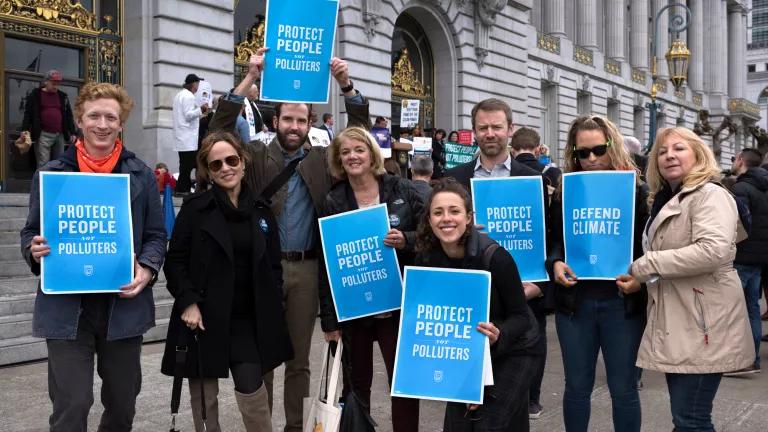The historic climate agreement signed in Paris opens the door to transformative changes that will help advance the fight against climate change. For Latin America, this agreement was vital. The region is one of the most vulnerable to climate change and the agreement lays the foundations to create more resilient communities and economies. The Paris agreement will also help mobilize new investment in key sectors such as clean energy, which will bring important local benefits while mitigating climate change emissions. During the climate summit several Latin American countries played a key role in helping the negotiations advance, demonstrating that the region is part of the climate solution. This international leadership and commitment to climate action must now be translated into concrete steps at the national level.
Emission reductions that will deepen over time
The Paris agreement enshrines reduction commitments by more than 180 countries - including all the largest emitters: China, US, India and the European Union. Importantly, the agreement establishes a mechanism by which countries will re-evaluate and deepen their climate commitments every five years, thus ensuring that the level of ambition will continue to increase. Transparency and accountability mechanisms were also strengthened to ensure that countries fulfill their commitments. This is a momentous step in the fight against climate change that will lead to concrete reductions in greenhouse gases and set us on a path toward even greater reductions so we can avoid the worst impacts of climate change. For Latin America, one of the most vulnerable regions in the world, the agreement is a critical step in the fight against climate change that will help ensure the well-being of its people.
A new commitment to adaptation
It is not surprising that 61% of Latin Americans believe that climate change is the most serious global threat, according to an international survey conducted by Pew researchers. The fact is that many of the 600 million Latin Americans live in areas or depend on economic sectors such as agriculture, fishing and tourism that are already highly vulnerable to climate change. Global warming threatens the region's coasts, glaciers and rich natural resources -its fisheries, corals, agricultural crops and its immense, incomparable biodiversity of species. Economic losses in the region due to climate change could amount to US $ 100 billion annually by 2050 according to estimates from the InterAmerican Development Bank. In the Paris negotiations, Latin American countries sought to highlight the importance of adaptation and the urgency to identify - and fund - responses to the worst impacts of climate change. In 2009, developed countries agreed to provide US $ 100 billion dollars by 2020. Now, the Paris Agreement establishes that this amount must be a starting point for the post-2020 period and the provision of financial resources should aim to achieve a balance between adaptation and mitigation.
Benefits of climate action
The Paris agreement will also facilitate a transition to low-carbon economies by mobilizing new investments in key sectors such as energy. Yet in addition to public funding, the Paris summit showed that many companies, investors, financial institutions and other actors are also willing to take climate action. In this sense Latin America, with its abundant renewable resources has much to gain. According to Bloomberg New Energy Finance, four of the top ten countries for clean energy investment are already in Latin America: Brazil, Chile, Mexico and Uruguay. Overall, in 2014, these four countries saw a total of US $ 23 billion in clean energy investments. An increase in these green investments means more jobs, public health improvements and savings in energy costs. For example, according to a recent analysis by the New Climate Institute, Chile could save US $ 5.3 billion each year on fossil fuels, avoid 1,500 deaths in Santiago due to air pollution and create 11,000 green jobs if it gets on a trajectory toward one hundred percent renewables. The countries of Latin America can - and should - bet on the clean energies of the future instead of tying themselves to infrastructure and energy systems of the last century. The Paris climate summit has given a clear signal that a transition to clean energy sources such as solar, wind and geothermal is urgent. Now it's up to each country to draw a roadmap to define how they will achieve this transition.
Latin America is part of climate change solution
During the negotiations that preceded the climate agreement, a number of countries from Latin America helped the discussions advance by building bridges between developing and developed countries and by showing their own willingness to act on climate. Their efforts highlighted that only through partnerships will we succeed in the fight against climate change.
Outside of the negotiations, countries and cities in Latin America are already a source of climate solutions. Over the years we have seen numerous examples of proactive solutions emerge from the region, such Bogotá's bus rapid transit system, Mexico's green mortgages, and Costa Rica's payments for environmental services. These and other examples are solutions that have been tested and can be replicated and scaled up in other parts of the continent and outside the region as well. The Paris agreement is a green light for climate solutions like these - solutions that not only help address greenhouse gases but are also a practical response to the region's sustainable development needs.




